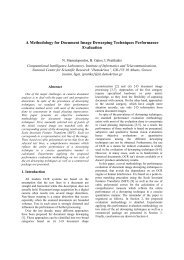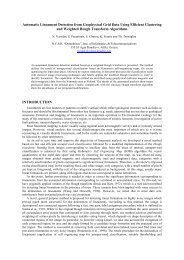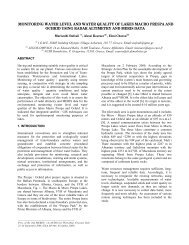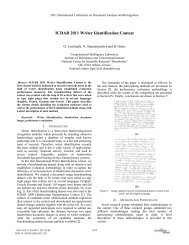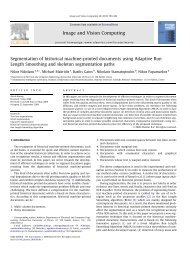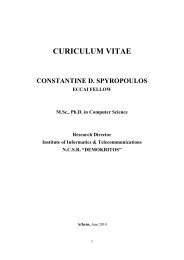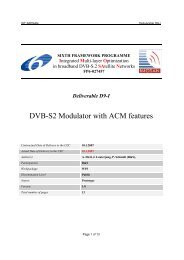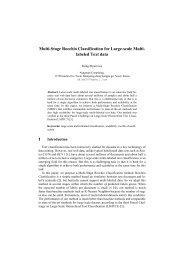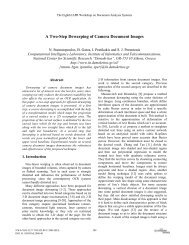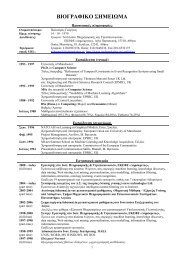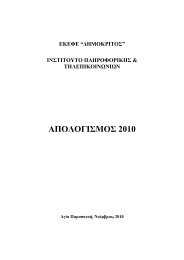TMS320C6713B Floating-Point Digital Signal Processor (Rev. A)
TMS320C6713B Floating-Point Digital Signal Processor (Rev. A)
TMS320C6713B Floating-Point Digital Signal Processor (Rev. A)
Create successful ePaper yourself
Turn your PDF publications into a flip-book with our unique Google optimized e-Paper software.
SPRS294A − OCTOBER 2005 − REVISED NOVEMBER 2005<br />
multichannel audio serial port (McASP) peripherals (continued)<br />
multichannel time division multiplexed (TDM) synchronous transfer mode<br />
The McASP supports a multichannel, time-division-multiplexed (TDM) synchronous transfer mode for both<br />
transmit and receive. Within this transfer mode, a wide variety of serial data formats are supported, including<br />
formats compatible with devices using the Inter-Integrated Sound (IIS) protocol.<br />
TDM synchronous transfer mode is typically used when communicating between integrated circuits such as<br />
between a DSP and one or more ADC, DAC, CODEC, or S/PDIF receiver devices. In multichannel applications,<br />
it is typical to find several devices operating synchronized with each other. For example, to provide six analog<br />
outputs, three stereo DAC devices would be driven with the same bit clock and frame sync, but each stereo DAC<br />
would use a different McASP serial data pin carrying stereo data (2 TDM time slots, left and right).<br />
The TDM synchronous serial transfer mode utilizes several control signals and one or more serial data signals:<br />
A bit clock signal (ACLKX for transmit, ACKLR for receive)<br />
A frame sync signal (AFSX for transmit, AFSR for receive)<br />
An (Optional) high frequency master clock (AHCLKX for transmit, AHCLKR for receive) from which the bit<br />
clock is derived<br />
One or more serial data pins (AXR for transmit and for receive).<br />
Except for the optional high-frequency master clock, all of the signals in the TDM synchronous serial transfer<br />
mode protocol are synchronous to the bit clocks (ACLKX and ACLKR).<br />
In the TDM synchronous transfer mode, the McASP continually transmits and receives data periodically (since<br />
audio ADCs and DACs operate at a fixed-data rate). The data is organized into frames, and the beginning of<br />
a frame is marked by a frame sync pulse on the AFSX, AFSR pin.<br />
In a typical audio system, one frame is transferred per sample period. To support multiple channels, the choices<br />
are to either include more time slots per frame (and therefore operate with a higher bit clock) or to keep the bit<br />
clock period constant and use additional data pins to transfer the same number of channels. For example, a<br />
particular six-channel DAC might require three McASP serial data pins; transferring two channels of data on<br />
each serial data pin during each sample period (frame). Another similar DAC may be designed to use only a<br />
single McASP serial data pin, but clocked three times faster and transferring six channels of data per sample<br />
period. The McASP is flexible enough to support either type of DAC but a transmitter cannot be configured to<br />
do both at the same time.<br />
For multiprocessor applications, the McASP supports any number of time slots per frame (between 2 and 32),<br />
and includes the ability to “disable” transfers during specific time slots.<br />
In addition, to support of S/PDIF, AES-3, IEC-60958, CP-430 receivers chips whose natural block (McASP<br />
frame) size is 384 samples; the McASP receiver supports a 384 time slot mode. The advantage to using the<br />
384 time slot mode is that interrupts may be generated synchronous to the S/PDIF, AES-3, IEC-60958, CP-430<br />
receivers, for example the “last slot” interrupt.<br />
burst transfer mode<br />
The McASP also supports a burst transfer mode, which is useful for non-audio data (for example, passing<br />
control information between two DSPs). Burst transfer mode uses a synchronous serial format similar to TDM,<br />
except the frame sync is generated for each data word transferred. In addition, frame sync generation is not<br />
periodic or time-driven as in TDM mode but rather data-driven.<br />
86 POST OFFICE BOX 1443 • HOUSTON, TEXAS 77251−1443



